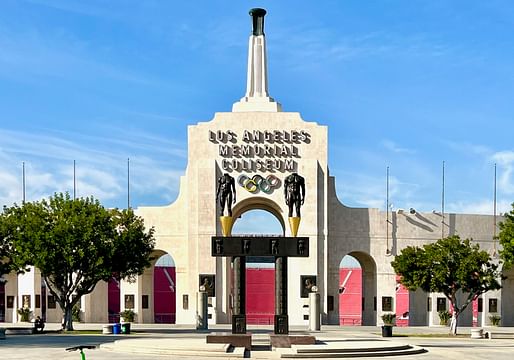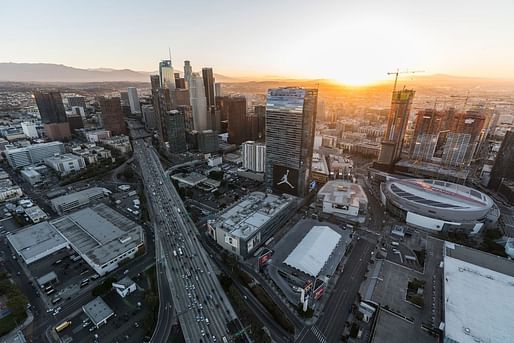

The American Institute of Architects Los Angeles (AIA|LA) has released an open letter sent to organizers of the 2028 Olympic and Paralympic Games on behalf of its members, encouraging their strategizing with the chapter toward outcomes they say will be a “big win” for multiple stakeholders in the community.
The text states the need for LA28 to consider the importance of placemaking and the games’ eventual aftermath, calling on organizers as a whole to work together on a progressive design agenda that benefits all while enshrining the region’s diversity and enhancing the events’ sustainable footprint.
Focusing on four key areas, the chapter’s letter calls for:
“Let’s collaborate on building a resilient and inclusive community engagement framework and leverage the 2028 Olympic & Paralympic as an opportunity for this framework to serve as a sustainable legacy to improve the future of Los Angeles,” the letter signed by the chapter's President, Leslie Sydnor, continues.

The build-up of the games has already prompted a host of changes to the urban fabric of Los Angeles, including the accelerated development of different transit options originating in Downtown, origination of small-scale infrastructure projects, a refurbishment of the Los Angeles Memorial Coliseum and other historic structures, capital improvement projects, and more.
Former LA Mayor Eric Garcetti had pitched a “No-Build” Olympics as part of the city’s winning bid, and officials are hoping for a repeat of the success of the 1984 games in the face of a housing crisis and rising homelessness that could undermine its presentation on the international stage that summer. Therefore, the letter argues, it is imperative for those with the position to heed the call for more public input and the expertise of architects who are in touch with the pertaining issues being raised therein.
(Jacobin published an incisive look at planning efforts and their local opposition earlier this spring that works as a primer to the AIA's appeal.)
Another letter concerning the development of affordable housing in Los Angeles was also penned by the chapter recently.
The full text of their message to the LA28 organizers can be accessed here.
4 Comments
Shouldnt you think about why no one wants to engage you when youre in the city .... maybe youre just so out of reach AIA LA
Where is the sense of urgency? Where is the engagement from the architectural community? Where is the activism in promoting a better design communities in moving towards a sustainable future? What is the role of the Architect when facing major crisis across the board like homelessness, income inequality, racism and the destruction of our planet? Is there any leadership?
This is a golden opportunity for all architects, the AIA, architecture schools like USC, UCLA, SCI-ARC, Woodbury and Cal Sate Pomona, artistes and designers in moving towards a sustainable future by reimagining LA's suburban model by involving yourself in Neighborhood Councils in a grass-roots approach.
I find it shocking in the lack of engagement when you have many programs and policies that LA are currently working and updating with the city's community plans, programs like Vision Zero, streamlining approval process for affordable housing, Outdoor dining (Al Fresco), Heathy Streets, Transit Oriented Communities (TOC), Metro projects like the East San Fernando Transit Corridor - Sepulveda Transit Corridor and building a robust bicycle infrastructure. Lets not forget the LA River Revitalization plan, Neighborhood Council system dealing with land use and planning, and urban policies like up-zoning single family neighborhoods.
There are interactive mapping tools like Metro LA's Active Transit Strategic Plan (ATSP) that just came out where you see potential growth and development in neighborhoods shown on its map by identifying as pedestrian districts. There are neighborhood council group meetings focusing on sustainability (NC Sustainability Alliance), and planning and land-use (PlanCheck NCLA) where there are a less than a handful of designers and architects showing up and listening to neighborhood concerns.
The AIA should write to their members to be more involve in community meetings, planning and land use policies where they are stakeholders and start to become more political and valuable in advancing for better design communities (more parks, open space, gardens, etc.). Architecture schools should have studios in neighborhoods that involves community engagement and show that architecture and urban design has a important role in reimagining their existing environment.
There should be a biennale in LA like Chicago and Venice in bringing a broader conversation of cities and get more people involved. Los Angeles has the potential than any other cities. Architects need to be involved in community meetings with all its warts in every city.
A major reason why professionals don't participate in greater numbers in these policy dicussions is the amount of public corruption which seems directly entangled with all major development in Los Angeles that makes rational planning both impossible and particpation professionally hazardous. Nearly all of these folks have had a hand in the LA 2028 Olympics Planning:
So it is acceptable for the architect that they cannot change the politics of land use policies and not hold our public servants accountable? I agree there is a rot in the city, but like I mentioned it's a golden opportunity to be a leader than a facilitator for corporate greed and the elite when life has become fluid (constantly evolving). Grass-roots activism is pushing the narrative where income inequality, the me-too movement, the climate crisis, the lack of trust in government and the polarization in society are at all time high and most of us want change.
Our cities are changing. There is a lot of talk and some movement about the new urbanism or re-imaging our existing built environment where streets are transforming itself from a car-centric to something else with density, housing, bike lanes, mass transportation infrastructure projects and outdoor street vending along sidewalks are evident.
As someone who engages in city government in the neighborhood council system, especially in the planing and land use committee meetings, it's not easy. There are a few neighborhood councils that has an architect as a board member when there are 99 neighborhoods and the architect is hardly there. Architects have the skill-set to explain what makes good design communities and the important role of architecture or art in building identity for the area, especially underserved areas like South LA.
I also meet with city planners in community events telling them zoning sucks in the housing element and it have undue consequences because you are seeing newer development in housing looking similar in a modernist style with flat roofs and some are incompatible to the neighborhood in terms of scale and proportion. At times, I would see projects that doesn't follow thru with the design of a facade but still received a certificate of occupancy after it has been built. There are many reasons why.
All I'm saying there is nothing to lose to show up at your local neighborhood council meetings when you start to listen and understanding neighborhood dynamics in urban development. How speaking and addressing them to your constituents can have a lasting effect from the bottom/up in a thoughtful and respectable manner.
Block this user
Are you sure you want to block this user and hide all related comments throughout the site?
Archinect
This is your first comment on Archinect. Your comment will be visible once approved.